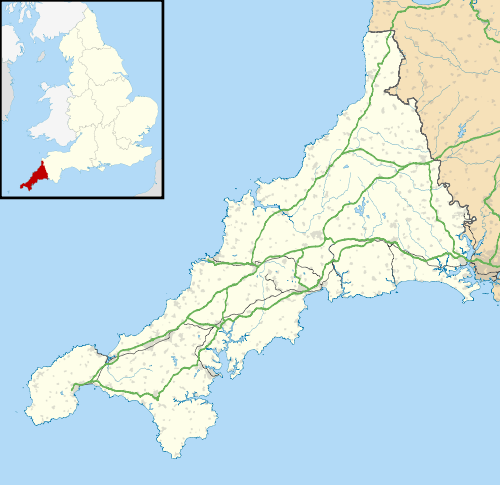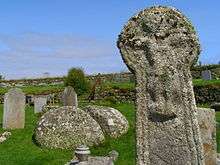St Levan
| St Levan | |
| Cornish: Selevan | |
 Parish church of St Levan |
|
 St Levan |
|
| Population | 459 (2011) |
|---|---|
| OS grid reference | SW3822 |
| Civil parish | St Levan |
| Unitary authority | Cornwall |
| Ceremonial county | Cornwall |
| Region | South West |
| Country | England |
| Sovereign state | United Kingdom |
| Post town | PENZANCE |
| Postcode district | TR19 |
| Dialling code | 01736 |
| Police | Devon and Cornwall |
| Fire | Cornwall |
| Ambulance | South Western |
| EU Parliament | South West England |
| UK Parliament | St Ives |
Coordinates: 50°02′28″N 5°39′43″W / 50.041°N 5.662°W
St Levan (Cornish: Selevan[1]) is a civil parish in Cornwall, England, United Kingdom. The parish is rural with a number of hamlets of varying size with Porthcurno probably being the best known. Hewn out of the cliff at Minack Point and overlooking the sea to the Logan Rock is the open-air Minack Theatre, the inspiration of Rowena Cade in the early 1930s.
St Levan lies within the Cornwall Area of Outstanding Natural Beauty (AONB) and the South West Coast Path, which follows the coast of south-west England from Somerset to Dorset passes by on the cliffs. There are two Sites of Special Scientific Interest (SSSI), designated for the vegetation and geology, and Gwennap Head in particular, is favoured by birdwatchers, many who travel the length and breadth of Britain to watch rare seabirds.
Geography
The parish church is about eight miles (12.7 km) south west of Penzance.[2] The parish measures 2,400 acres (10 km2) and the population at the 2011 census was 459. The river in the valley at Nanjizal forms the parish boundary with Sennen and is 3 miles south of the Land's End. From Nanjizal heading south and east, via Gwennap Head, there is 4 miles of coast to Penberth Cove and the boundary with St Buryan. The parish encompasses a number of small settlements which include Bottoms, Penberth, Polgigga, Porthgwarra, Trebehor, Treen (the chief village) and Trethewey.[3] Both Penberth and Porthgwarra in the past had small fishing fleets despite not having harbour; the boats were hauled up the slipways when not in use. A small fleet continues to fish out of Penberth, for bass (Dicentrarchus labrax), crabs and mackerel (Scomber scombrus).[3]
History
Neolithic flints have been found dating human activity in the area to 5000 years ago. Fifteen-hundred pieces of worked flint and chert from the Bronze Age were found during the 1914 excavation at Pedn-men-an-mere[3][4] and a Iron Age, cliff castle at Treryn Dinas may date back 2000 years or more.[5]
Many of the hamlets and farms with Cornish prefixs such at Bos and Tre (and possibly Ros) can trace their names back to 600–700 AD while Chy dates back to the 11th- or 12th-century. The first documentary evidence of a place name is Rospletha, which is mentioned in 1244 and the rest of the other farms are recorded over the next one hundred years.[3] Much of the land belonged to the manor of Mayon, Sennen and in the early 17th-century the land was divided between six heiresses; one of whom married John St Aubyn. A later John St Aubyn, became the first Baron St Levan of St Michael's Mount. Much of Porthgwarra, the land around Gwennap Head, as well as the farms Higher Bosistow, Roskestral, Sawah, Trebehor and Trevean are still part of the St Aubyn Estate.[3][6]
Above the sandy beach at Porthchapel is a ruined rectangular building with a large flat granite slab and spring known as St Levan's Well. Below and cut into the cliff slope are a couple of buildings believed to be an early chapel and cell. The remains possibly date to the 7th- or 8th-century.[7] St Levan's Church is situated in a small valley, inland from Porthchapel. It dates mainly from the 15th-century with earlier font, north transept and nave/chancel.[8] Until 1864 the church was a chapelry of the Royal Peculiar of the Deanery of St Buryan. It is now part of the united benefice of St Buryan and St Sennen. There are also two Wesleyan Methodists chapels at Treen (1834) and Trethewey (1868).[9][10]
The first telegraph cable, (from Carcavelos, near Lisbon) was laid on Porthcurno beach in 1870. Lisbon had already been linked to Bombay, making Porthcurno the British terminal of the Empire's telegraph network. A land link was provided to London helping to make Porthcurno a centre of world communications. The Eastern Telegraph Company was formed in 1872, later to become Cable & Wireless and Porthcurno was also a training centre, sending operatives all over the world.[3][11]
Governance
For the purposes of local government St Levan is a civil parish and every four years elects a parish council consisting of ten councillors. The principal local authority is Cornwall Council.
Wildlife and ecology
Much of the coast of St Levan parish is designated as a Site of Special Scientific Interest (SSSI) and noted for the vegetation of waved maritime heath and for the geology. Heaths are widespread worldwide but are fast disappearing and considered a rare habitat in Europe. Rock sea lavender (Limonium loganicum) is an endemic plant that is found only in the parish of St Levan. All the colonies are within protected areas but may be vulnerable from climbers or walkers on the lower slopes where it occurs.[12]
Treen Cliff SSSI extends from Porthcurno beach in the west to Penberth Cove in the east. Several rare plant species occur and the site is of particular importance for its maritime heath.[13] Part of the site, Treryn Dinas, is a Scheduled Ancient Monument consisting of a "cliff castle" with four ramparts and ditches, and the Logan Rock was part of the tour of the Land's End area for Victorian tourists. The Porthgwarra to Pordenack Point (SSSI) is noted for its vegetation, and for being of considerable ornithological interest; especially for passage migrants. It is renowned for its relative abundance of passing marine bird species with many common species such as northern gannet (Morus bassanus), Manx shearwater (Puffinus puffinus), common guillemot, (Uria aalge) and razorbill (Alca torda), as well as rarer birds such as Balearic shearwater (Puffinus mauretanicus) and Cory's shearwater (Calonectris borealis).[14] The headland of Tol-pedn (or Gwennap Head) is favoured by birdwatchers and many travel the length and breadth of Britain to track rare seabirds.[15][16]
Some of the butterflies that can be found on the coast include grayling (Hipparchia semele), silver-studded blue (Plebejus argus), small pearl-bordered fritillary (Boloria selene) and wall (Lasiommata megera). There is also a day-flying moth, the thrift clearwing (Synansphecia muscaeformis); the adult is a bee mimic and the larva feed on thrift (Armeria maritima).
Education
St. Levan CP School is St Levan's community primary school, located in the hamlet of Bottoms. It is a very small school. Its current head teacher is Susannah Storey.
Notable residents
- Harry Etchel Binns (c 1870–1945), a member of the Newlyn School
- William Bottrell (b 1816), writer of three volumes of Cornish folk stories
- Rowna Cade (1893–1983), designer of the Minack Theatre
- Thomasine Dennis, the first Cornishwomen to write a novel, Sophia St Clare
- John Piper (1903–1992), artist
- Bertrand Russell (1872–1970), philosopher
- James Howard Williams (1897–1958), known as Elephant Bill, soldier, elephant expert and author
References
- ↑ Place-names in the Standard Written Form (SWF) : List of place-names agreed by the MAGA Signage Panel. Archived 15 May 2013 at the Wayback Machine. Cornish Language Partnership.
- ↑ Ordnance Survey: Landranger map sheet 203 Land's End ISBN 978-0-319-23148-7
- 1 2 3 4 5 6 7 St Levan Local History Group (2004). The Book of St Levan. Tiverton: Halsgrove. ISBN 1 84114 328 6.
- ↑ "MONUMENT NO. 421312". PastScape. Historic England. Retrieved 4 November 2015.
- ↑ "TRERYN DINAS". PastScape. Historic England. Retrieved 4 November 2015.
- ↑ Gendall, Christine (1999). Porthgwarra. St Buryan: Churchtown Technology. p. 60.
- ↑ "ST LEVANS WELL AND CHAPEL". PastScape. Historic England. Retrieved 4 November 2015.
- ↑ "CHURCH OF ST LEVAN". PastScape. Historic England. Retrieved 4 November 2015.
- ↑ "TREEN WESLEYAN METHODIST CHAPEL". PastScape. Historic England. Retrieved 4 November 2015.
- ↑ "TREEN WESLEYAN METHODIST CHAPEL". PastScape. Historic England. Retrieved 4 November 2015.
- ↑ "Porthcurno Telegraph Station". PastScape. Historic England. Retrieved 17 November 2015.
- ↑ Bennallick, I.J., French, C.N., and Parslow, R.E. (2009) Vascular Plants. In CISFBR, Red Data Book for Cornwall and the Isles of Scilly. 2nd Edition. Praze-an-Beeble: Croceago Press.
- ↑ "Treen Cliff" (PDF). Natural England. 1 July 1986. Retrieved 5 November 2015.
- ↑ Lawman, Jean (2002). A Natural History of Land's End. Padstow: Tabb House. ISBN 1 873951 40 X.
- ↑ "Porthgwarra to Pordenack Point" (PDF). Natural England. 1986. Retrieved 5 November 2015.
- ↑ "Wildlife of Gwennap Head". National Coastwatch. Retrieved 16 December 2014.
External links

| Wikimedia Commons has media related to St Levan. |
| Wikivoyage has a travel guide for St Levan. |